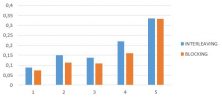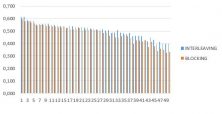In an earlier post, we explained the difference between interleaving and blocked practice. Remember that interleaving (mixed practice) basically consists of organizing tasks by mixing different problems and exercises together in order to avoid solving problems in a mechanical way and instead stimulating the child to reflect on the strategy needed to solve each problem. The research says that interleaving produces better results than blocked practice.
At Smartick, a method that tries to base most of the product on research results, we have considered how to systematically incorporate interleaving into our daily 15 minute sessions.
How do we apply interleaving in Smartick?
Of the math tasks that Smartick presents to students, there is a basic distinction between problems and exercises. A few months ago, at the end of each Smartick Session, we proposed problems using the interleaving method to develop the students’ reasoning as much as possible. Our goal was to optimize mathematical learning in daily sessions by incorporating the principles of interleaving to the rest of the session, that is, to the initial part of a session (within a maximum of 12 minutes) related to exercises.
Smartick’s contents are organized into learning trajectories made up of units and daily lessons dedicated to specific contents. For example, the content could be symmetry, subitizing, a series with a repeating pattern, etc. So, Smartick’s exercises were organized into blocked practice, and that’s the part we wanted to optimize by including some mixed practice (interleaving).
In order to see how we could apply the principles of interleaving to Smartick, we conducted an experimental study. Students were randomly divided into two groups. A control group (6405 students) who continued to do their daily sessions with blocked practice and an experimental group (6209 students) whose sessions incorporated a variation that introduced interleaving into their exercises.
During Smartick’s 15 minute sessions, a lesson is presented every day. Given that each student works at their own pace they could complete a lesson in one day or take a few sessions to do so. The statistical analysis that we did on the sessions brought us to the conclusion that, on average, the students who completed the lesson had three minutes to spare in the session. In the control group, these three minutes were used to start a different lesson continuing with blocked practice. With the experimental group, the students were presented a mix of exercises from lessons that they had previously completed in the last 90 days.
In order to compare the performance of the control and experimental groups, we used the review sessions as instruments. Every 15-20 days they would be presented with a combination of mixed problems that they had solved incorrectly since the previous review session. We also collected the success percentages from the daily lesson exercises presented in each session (without mixed problems), the average response time (ARM), and a measurement that captures both the success rate and response time (FS).
During the more than two months that we conducted the experiment, we collected data from a total of 28,247 review sessions and compared their success percentages. The graph below shows the scores that reflect the success percentages and their response times (FS). As we can see in the five review sessions, the scores were higher in the interleaving group than the control group. The same happened with the success rates and response time.

A result that we did not expect to find was that the interleaving group also performed better during the daily lessons (blocked practice) than the control group. The research states that the interleaving results are higher when evaluated by examinations with mixed exercises, which makes sense.
In a total of 328,664 sessions, we observed the results displayed on the graph below. This represents the average success percentage in both groups over the course of the 50 sessions in the experiment. In the graph, we see how the difference in favor of the interleaving group increases with the passage of sessions. All of the results found have been statistically significant.

This experimental study, with its academic limitations, belongs to a series of experiments conducted by Smartick based on the readings of research results. They have been compared by our data analysis team with the goal of continuously improving our online teaching system and offering the very best to each student that uses Smartick.
From this experiment, all Smartick students have gone on to perform three minutes of mixed (interleaving) practice a day. All the decisions and changes we make at Smartick are based on both theory and data analysis. At the very least we strive to provide math education based on the best scientific evidence available.
Learn More:
- Interleaving vs Blocked Practice to Learn Math
- First Results of Smartick and Smartick Brain in Schools
- The Five Stages of Deliberate Practice
- Maths Daily Practice – Smartick Review
- Improve Your Child’s Math Skills with Smartick







